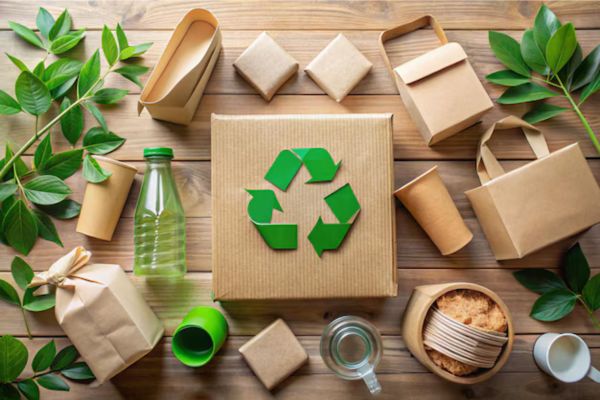Today, more than ever, the need for eco-friendly packaging is impossible to ignore. With growing awareness among consumers and tighter environmental regulations, the packaging industry is being pushed to make big changes. Artificial Intelligence (AI) is playing a key role in this shift helping companies design smarter, greener, and more efficient packaging that reduces waste and supports sustainability goals.
From cutting waste to designing smarter boxes and streamlining logistics, AI in sustainable packaging is gaining serious traction. And we’re not talking about small improvements forecasts show the market will witness hundreds of millions in revenue growth between 2025 and 2034. So, what exactly is driving this growth? And how are companies leveraging AI to build a more sustainable future?
The Marriage of Tech and Sustainability
At its core, AI in sustainable packaging refers to the use of technologies like machine learning, computer vision, and advanced data analytics to improve how packaging is designed, manufactured, and managed. It’s about doing more with less. Less plastic, less energy, less waste but with better results.
Whether it’s choosing the right material, reducing the use of excess packaging, or improving recycling systems, AI tools are making processes more intelligent and resource-conscious.
Design Smarter, Waste Less
One of the biggest impacts AI is making is in packaging design. Traditional design methods relied heavily on experience and estimation. But AI flips the script. Now, brands can input product specifications and let algorithms determine the most efficient, recyclable, and cost-effective packaging solution.
The result? Less material use, lower carbon footprints, and packaging that’s tailored for recyclability. Unsurprisingly, this segment led the market in 2024 and it’s not slowing down.
Automation and AI: A Perfect Match
In logistics and manufacturing, AI is revolutionizing operations. Automated warehouses are using AI to right-size boxes, which means less air in packages and fewer trucks on the road. It’s a simple concept with a massive environmental payoff.
Meanwhile, AI vision systems are spotting flaws during production in real-time, slashing waste and improving quality. In supply chains, predictive algorithms are helping companies plan smarter reducing overproduction and optimizing inventory, all of which reduce unnecessary resource use.
From Passive to Smart: The Rise of Interactive Packaging
We’re not just talking about recyclable materials anymore. The latest wave of sustainable packaging includes smart, embedded tech QR codes, RFID tags, and even freshness sensors. These features give consumers real-time data about their products’ sustainability, shelf life, and origin.
Imagine a piece of fish wrapped in a biodegradable package that tells you when it’s about to spoil and releases natural preservatives to extend freshness. That’s not sci-fi it’s already happening, and AI is the brain behind it.
The Circular Economy Gets a Tech Boost
Circular economy models where materials are reused or recycled instead of discarded are becoming essential. AI is playing a critical role here too. In recycling plants, AI-powered sorting systems identify and separate recyclable materials with a level of accuracy humans can’t match.
Companies are also using AI to track packaging across its lifecycle, helping ensure that materials are recovered and reused. Blockchain technology and AI are even coming together to introduce carbon labeling and traceability, allowing eco-conscious consumers to make more informed choices.
Challenges Still Exist
Despite the promise, adopting AI in sustainable packaging isn’t without its hurdles. Many companies, especially smaller ones or those in developing markets, struggle with the lack of technical expertise or digital infrastructure. There’s also hesitation when it comes to changing traditional processes or navigating data privacy issues.
But these challenges are far from insurmountable. As success stories grow and accessible solutions hit the market, adoption is expected to accelerate.
E-commerce: A Major Driving Force
Online retail is booming and it’s one of the biggest drivers of sustainable packaging innovation. In 2025 alone, global e-commerce sales are projected to hit $6.86 trillion. That’s a lot of boxes, bags, and containers.
To meet demand while minimizing environmental harm, e-commerce giants and packaging suppliers are turning to AI. From improving box sizes to streamlining returns and reducing excess packaging, AI is helping brands scale up without sacrificing sustainability.
What the Future Holds
Looking ahead, the AI in sustainable packaging market is positioned for significant growth across regions and industries. North America continues to lead today, but Asia Pacific is emerging as a hotbed for innovation, driven by rapid digitalization and a rising eco-conscious middle class.
Machine learning remains the dominant AI technology for now, but Natural Language Processing (NLP) and computer vision are catching up quickly, powering smart logistics, real-time analytics, and personalized packaging experiences.
Final Thoughts
AI isn’t just helping companies cut costs it’s becoming a vital tool for achieving broader environmental and regulatory goals. From food and beverage brands to pharmaceuticals and e-commerce retailers, businesses are waking up to the value of smart, sustainable packaging.
What once felt like a futuristic vision is now a real-world solution. As we head into the next decade, AI is set to play an even greater role in how we design, produce, and think about packaging.
And if the current momentum is anything to go by, the intersection of AI and sustainability is only just getting started.
















